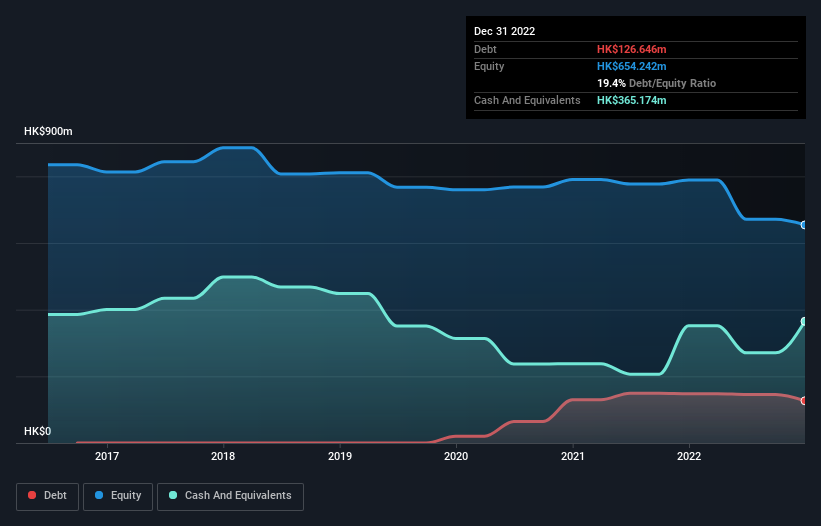
Warren Buffett famously said, 'Volatility is far from synonymous with risk.' So it seems the smart money knows that debt - which is usually involved in bankruptcies - is a very important factor, when you assess how risky a company is. As with many other companies Tianda Pharmaceuticals Limited (HKG:455) makes use of debt. But is this debt a concern to shareholders?
When Is Debt Dangerous?
Debt is a tool to help businesses grow, but if a business is incapable of paying off its lenders, then it exists at their mercy. Part and parcel of capitalism is the process of 'creative destruction' where failed businesses are mercilessly liquidated by their bankers. However, a more common (but still painful) scenario is that it has to raise new equity capital at a low price, thus permanently diluting shareholders. Of course, plenty of companies use debt to fund growth, without any negative consequences. When we think about a company's use of debt, we first look at cash and debt together.
View our latest analysis for Tianda Pharmaceuticals
What Is Tianda Pharmaceuticals's Net Debt?
As you can see below, Tianda Pharmaceuticals had HK$126.6m of debt at December 2022, down from HK$147.9m a year prior. But on the other hand it also has HK$365.2m in cash, leading to a HK$238.5m net cash position.

A Look At Tianda Pharmaceuticals' Liabilities
According to the last reported balance sheet, Tianda Pharmaceuticals had liabilities of HK$362.4m due within 12 months, and liabilities of HK$71.8m due beyond 12 months. Offsetting this, it had HK$365.2m in cash and HK$142.8m in receivables that were due within 12 months. So it can boast HK$73.8m more liquid assets than total liabilities.
This surplus suggests that Tianda Pharmaceuticals is using debt in a way that is appears to be both safe and conservative. Due to its strong net asset position, it is not likely to face issues with its lenders. Simply put, the fact that Tianda Pharmaceuticals has more cash than debt is arguably a good indication that it can manage its debt safely. When analysing debt levels, the balance sheet is the obvious place to start. But it is Tianda Pharmaceuticals's earnings that will influence how the balance sheet holds up in the future. So if you're keen to discover more about its earnings, it might be worth checking out this graph of its long term earnings trend.
Over 12 months, Tianda Pharmaceuticals reported revenue of HK$547m, which is a gain of 5.8%, although it did not report any earnings before interest and tax. We usually like to see faster growth from unprofitable companies, but each to their own.
So How Risky Is Tianda Pharmaceuticals?
Although Tianda Pharmaceuticals had an earnings before interest and tax (EBIT) loss over the last twelve months, it generated positive free cash flow of HK$69m. So although it is loss-making, it doesn't seem to have too much near-term balance sheet risk, keeping in mind the net cash. We'll feel more comfortable with the stock once EBIT is positive, given the lacklustre revenue growth. There's no doubt that we learn most about debt from the balance sheet. However, not all investment risk resides within the balance sheet - far from it. For example, we've discovered 3 warning signs for Tianda Pharmaceuticals (1 is significant!) that you should be aware of before investing here.
When all is said and done, sometimes its easier to focus on companies that don't even need debt. Readers can access a list of growth stocks with zero net debt 100% free, right now.
Valuation is complex, but we're here to simplify it.
Discover if Tianda Pharmaceuticals might be undervalued or overvalued with our detailed analysis, featuring fair value estimates, potential risks, dividends, insider trades, and its financial condition.
Access Free AnalysisHave feedback on this article? Concerned about the content? Get in touch with us directly. Alternatively, email editorial-team (at) simplywallst.com.
This article by Simply Wall St is general in nature. We provide commentary based on historical data and analyst forecasts only using an unbiased methodology and our articles are not intended to be financial advice. It does not constitute a recommendation to buy or sell any stock, and does not take account of your objectives, or your financial situation. We aim to bring you long-term focused analysis driven by fundamental data. Note that our analysis may not factor in the latest price-sensitive company announcements or qualitative material. Simply Wall St has no position in any stocks mentioned.
About SEHK:455
Tianda Pharmaceuticals
Engages in the research and development, manufacture, and sale of pharmaceutical, biotechnology, and healthcare products in Mainland China, Hong Kong, and Australia.
Adequate balance sheet low.
Market Insights
Community Narratives




